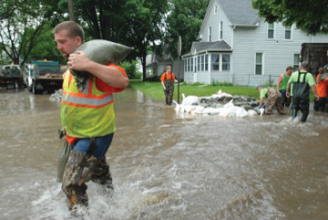
Archived Content
This site contains information that has been considered archived and will no longer be updated.
Economic Disaster Recovery – The Calm after the Storm

When devastating events wreak havoc on lives and communities, EDA has been there to aid those affected by a disaster.
The following success story shows how EDA’s role in helping Louisiana respond to recent flooding has made them more resilient:
Louisiana Flooding
Louisiana endured two devastating floods in 2016. Torrential rains in March and August resulted in rivers reaching historic flood levels throughout the state. 57 of Louisiana’s 64 parishes were impacted, with an estimated combined 26,000 businesses affected, including an estimated $367 million in agriculture losses.
In response to the initial flooding in March 2016, the EDA-led Economic Recovery Support Function (Economic RSF) was activated to lead economic recovery efforts in the impacted communities. When additional flooding occurred in August 2016, the Economic RSF’s mission was extended and tasked to assist the state during both flooding disasters.
The Economic Recovery Support Function (ERSF) continues to aid economic recovery activities in all impacted Louisiana parishes in cooperation with the federal, State, local, and non-profit partners.
Understanding the value of having State partners fully engaged in the economic recovery process, the ERSF team requested that a Louisiana Economic Development employee be embedded with the team to inform their processes.
Creation of the Louisiana Supply Chain and Transportation Council

The ERSF conducted extensive outreach to public and private transportation experts in the impacted areas regarding the closures. Based on the information collected, the Economic RSF aided in developing a strategy for the creation of a Louisiana Supply Chain and Transportation Council (Council) to address closures of major transportation routes, leading to a Concurrent Resolution passed by the Louisiana Legislature addressing the issue.Louisiana’s historic floods of 2016 caused widespread disruption to all modes of transportation, causing negative impacts to the state’s economy. For example, the J. Bennett Johnson Red River Waterway was closed for almost two months. The closure caused negative impacts to several major industries that depended on the ports. Additionally, all interstate highway systems were closed at least once, as were railroads. The closure of the transportation modes caused cascading impacts to businesses in the state as many employees were not able to get to work.
The Resolution includes a request for a report outlining measures needed to make Louisiana’s transportation system more reliable. Council leadership is actively seeking support for ongoing operation and development of the legislative report. The Council has voted to change its name to the Louisiana Resilient Infrastructure Council, and broaden its mission to address resilience issues for all infrastructure, including cyber communications.
